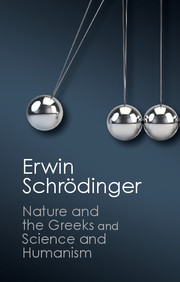Book contents
- Frontmatter
- Contents
- Foreword
- NATURE AND THE GREEKS
- SCIENCE AND HUMANISM
- Dedication
- Preface
- The spiritual bearing of science on life
- The practical achievements of science tending to obliterate its true import
- A radical change in our ideas of matter
- Form, not substance, the fundamental concept
- The nature of our ‘models’
- Continuous description and causality
- The intricacy of the continuum
- The makeshift of wave mechanics
- The alleged break-down of the barrier between subject and object
- Atoms or quanta-the counter-spell of old standing, to escape the intricacy of the continuum
- Would physical indeterminacy give free will a chance?
- The barto prediction, according to Niels Bohr
Atoms or quanta-the counter-spell of old standing, to escape the intricacy of the continuum
Published online by Cambridge University Press: 05 October 2014
- Frontmatter
- Contents
- Foreword
- NATURE AND THE GREEKS
- SCIENCE AND HUMANISM
- Dedication
- Preface
- The spiritual bearing of science on life
- The practical achievements of science tending to obliterate its true import
- A radical change in our ideas of matter
- Form, not substance, the fundamental concept
- The nature of our ‘models’
- Continuous description and causality
- The intricacy of the continuum
- The makeshift of wave mechanics
- The alleged break-down of the barrier between subject and object
- Atoms or quanta-the counter-spell of old standing, to escape the intricacy of the continuum
- Would physical indeterminacy give free will a chance?
- The barto prediction, according to Niels Bohr
Summary
Be this as it may, it seems worth our while to try to examine the matter from various angles. A point of view that I have previously touched on in these lectures and that does suggest itself is this, that our present difficulties in physical science are bound up with the notorious conceptional intricacy inherent in the idea of the continuum. But this does not tell you much. How are they bound up? What precisely is the mutual relationship?
If you envisage the development of physics in the last half-century, you get the impression that the discontinuous aspect of nature has been forced upon us very much against our will. We seemed to feel quite happy with the continuum. Max Planck was seriously frightened by the idea of a discontinuous exchange of energy, which he had introduced (1900) in order to explain the distribution of energy in black-body-radiation. He made strong efforts to weaken the hypothesis, and, if possible, to get away from it, but in vain. Twenty-five years later the inventors of wave mechanics indulged for some time in the fond hope that they had paved the way of return to a classical continuous description, but again the hope was deceptive.
- Type
- Chapter
- Information
- 'Nature and the Greeks' and 'Science and Humanism' , pp. 157 - 162Publisher: Cambridge University PressPrint publication year: 2014



